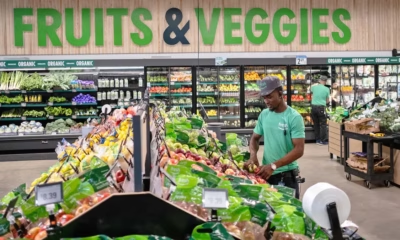Tech & E-Commerce
Can Regional Grocers Compete with Walmart’s Dominance?

Walmart continues to strengthen its position in the online grocery sector, posing a significant challenge to regional grocers across the United States. According to a recent report by Brick Meets Click and Mercatus, Walmart accounted for an impressive 37% of U.S. online grocery sales in Q2 2024—a sharp increase from previous years. This dominance places immense pressure not only on regional players but also on national chains like Kroger, Albertsons, and Publix.
Why is Walmart Investing So Heavily in Ecommerce?
Walmart has committed substantial resources to enhancing its online grocery experience, leveraging technology and aggressive pricing strategies to attract customers. The company’s global ecommerce sales grew by 20% year-over-year, proving that online grocery shopping is more than just a pandemic-driven trend. According to Grocery Dive and Brick Meets Click, grocery ecommerce sales are expected to grow three times faster than in-store sales, with a projected compound annual growth rate of 4.5% over the next five years, compared to just 1.3% for in-store shopping.
Walmart’s market share growth has been fueled by several key factors:
- Rural and Suburban Reach – With over 4,600 U.S. stores, 99% of Americans live within 15 miles of a Walmart, providing unmatched pickup convenience.
- Price-Sensitive Shoppers – Amid inflation, Walmart’s low-price reputation attracts budget-conscious customers who seek both affordability and convenience.
- Time-Strapped Consumers – Walmart’s advanced fulfillment and delivery options cater to busy shoppers looking for seamless grocery experiences.
How Can Regional Grocers Compete?
Despite Walmart’s dominance, regional grocers are not without options. By focusing on their unique strengths and leveraging technology, smaller retailers can build stronger customer loyalty and differentiate themselves. Here are key strategies that can help regional grocers stay competitive:
1. Hyperlocal Focus
Regional grocers should highlight locally sourced products and strengthen partnerships with regional suppliers. Consumers appreciate fresh, local offerings, which can serve as a key differentiator against mass retailers.
2. Loyalty & Personalization Programs
Loyalty programs must be at the center of a regional grocer’s strategy. Providing personalized recommendations, targeted promotions, and exclusive discounts strengthens customer relationships. A well-executed omnichannel approach ensures customers engage with the brand both online and in-store.
3. Enhanced Convenience Through Delivery & Pickup
Offering both first-party and third-party delivery options can help regional grocers remain competitive. Walmart reported that 30% of its online grocery customers paid a convenience fee for delivery in three hours or less—proving that speed is a crucial factor in customer satisfaction.
4. Investing in Retail Media
Retailers of all sizes should develop a strong retail media strategy. Digital advertising within grocery ecommerce platforms can generate additional revenue while improving the shopping experience with personalized promotions.
5. Strengthening Order Management & Fulfillment
A seamless online ordering process is only as effective as the fulfillment operation behind it. Grocers must invest in robust order management systems to scale efficiently and avoid delays. Without proper fulfillment, even the best ecommerce platforms will struggle to retain customers.
6. Pickup Enhancements
Despite the rise in delivery, pickup remains a crucial component of online grocery. From October 2023 to October 2024, grocery pickup sales grew 20%, totaling $4.2 billion. Grocers should optimize pickup logistics by:
- Expanding pickup time slots
- Using location tracking to reduce wait times
- Implementing upsell opportunities at pickup points
7. Reducing Substitutions
Substitutions remain one of the top consumer complaints in grocery ecommerce. By integrating perpetual inventory solutions with ecommerce platforms, grocers can provide real-time stock updates and minimize unexpected substitutions, improving customer satisfaction.
8. Expanding Fresh & Made-to-Order (MTO) Options
Offering fresh, made-to-order meals alongside groceries can increase shopping frequency and foster loyalty. Customers appreciate the ability to grab dinner alongside their grocery order, making this a valuable addition to any regional grocer’s strategy.
Inaction is Not an Option
The worst response to Walmart’s growing dominance is doing nothing. Regional grocers must be proactive in adopting innovative solutions to keep pace with industry changes. AI-driven advancements are transforming retail at a rapid pace, and retailers that fail to innovate risk losing their customer base.
Fortunately, cloud-based technology solutions can help smaller grocers implement these strategies efficiently. While some retailers may have in-house IT teams to develop custom solutions, many lack the resources or expertise to do so. Cloud-based ecommerce, order fulfillment, and retail media platforms provide cost-effective, scalable alternatives that allow regional grocers to compete effectively—without requiring massive upfront investments.
By embracing these strategies and prioritizing innovation, regional grocers can carve out a strong position in an increasingly digital grocery landscape, maintaining customer loyalty and driving long-term growth.





















